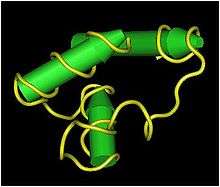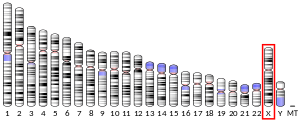ARMCX6
Armadillo repeat containing X-linked 6 is a protein that in humans is encoded by the ARMCX6 gene located on the X-chromosome.[5]
| ARMCX6 | |||||||||||||||||||||||||
|---|---|---|---|---|---|---|---|---|---|---|---|---|---|---|---|---|---|---|---|---|---|---|---|---|---|
| Identifiers | |||||||||||||||||||||||||
| Aliases | ARMCX6, GASP10, armadillo repeat containing, X-linked 6, armadillo repeat containing X-linked 6 | ||||||||||||||||||||||||
| External IDs | MGI: 2147993 HomoloGene: 10373 GeneCards: ARMCX6 | ||||||||||||||||||||||||
| |||||||||||||||||||||||||
| |||||||||||||||||||||||||
| Orthologs | |||||||||||||||||||||||||
| Species | Human | Mouse | |||||||||||||||||||||||
| Entrez | |||||||||||||||||||||||||
| Ensembl | |||||||||||||||||||||||||
| UniProt | |||||||||||||||||||||||||
| RefSeq (mRNA) | |||||||||||||||||||||||||
| RefSeq (protein) | |||||||||||||||||||||||||
| Location (UCSC) | Chr X: 101.62 – 101.62 Mb | Chr X: 134.75 – 134.75 Mb | |||||||||||||||||||||||
| PubMed search | [3] | [4] | |||||||||||||||||||||||
| Wikidata | |||||||||||||||||||||||||
| |||||||||||||||||||||||||
It is one of six armadillo repeats containing X-linked proteins (ARMCX1, ARMCX2, ARMCX3, ARMCX4, ARMCX5, and ARMCX6 (this protein)).
The function of this protein is unknown at this time.
Protein sequence
1 MGRAREVGWM AAGLMIGAGA CYCVYKLTIG RDDSEKLEEE
41 GEEEWDDDQE LDEEEPDIWF DFETMARPWT EDGDWTEPGA
81 PGGTEDRPSG GGKANRAHPI KQRPFPYEHK NTWSAQNCKN
121 GSCVLDLSKC LFIQGKLLFA EPKDAGFPFS QDINSHLASL
161 SMARNTSPTP DPTVREALCA PDNLNASIES QGQIKMYINE
201 VCRETVSRCC NSFLQQAGLN LLISMTVINN MLAKSASDLK
241 FPLISEGSGC AKVQVLKPLM GLSEKPVLAG ELVGAQMLFS
301 FMSLFIRNGN REILLETPAP
Homology
ARMCX6 is conserved in many eukaryotic organisms.
Orthologs
| taxonomic name | common name | NCBI entry | Percentage of sequence similarity | Length (AAs) | comments |
| Homo sapiens | Human | 100% | 300 | armadillo repeat containing X-linked 6 | |
| Macaca mulatta | Rhesus monkey | 97.0% | 300 | PREDICTED: similar to amrmadillo repeat containing, X-linked 6 (H. sapiens)-like isoform 1 | |
| Equus caballus | Horse | 90.0% | 300 | PREDICTED: similar to armadillo repeat containing, X-linked 6 | |
| Danio rerio | zebrafish | 84.0% | 301 | Similar to RIKEN cDNA 0610039K22 | |
| Mus musculus | House Mouse | 97.7% | 393 | armadillo repeat containing, X-linked 6 (H. sapiens)-like | |
| Bos taurus | cow | 83.0% | 301 | armadillo repeat containing, X-linked 6 | |
| Mus musculus | Mouse | 82.0% | 301 | armadillo repeat containing, X-linked 6 | |
| Takifugu rubripes | Tetradontoidea | 66.0% | 818 | aryl hydrocarbon receptor 2C | |
| Caenorhabditis elegans | C. elegans | 50.0% | 332 | Serpentine Receptor, class H family member (srh-216) | |
| Saccharomyces cerevisiae | Yeast | 70.0% | 910 | Hul5p | |
| Gallus gallus | Chicken | 52.0% | 317 | PREDICTED: hypothetical protein | |
Secondary Structure
The secondary structure of ARMCX6 is predicted to be similar to cyanase. A comparison of the two sequences is shown below.[6][7]
10 20 30 40
....*....|....*....|....*....|....*....|....*..
ARMCX6 231 MLAKSASDLKFPLISEGSGCAKVQVLKPLMGLSEKPVLAGELVGAQM 277
1DW9_A 19 LLSKAKKDLSFAEIADGTGLAEAFVTAALLGQQALPADAARLVGAKL 65
+ + ++ + + + + + + + + + + ++++

Cyanase segment having identity with ARMCX6.
Expression
Microarray data show that ARMCX6 is highly expressed during earliest stages of spermatogenesis in mice.[8][9][10]
gollark: Except then the awful go program I use to proxy websockets consumes all of *two* cores.
gollark: The CPU usage is fine when someone is connected.
gollark: Oh. Right. When it has no connections, it must something.
gollark: Yes, that's the question, isn't it.
gollark: I checked the parent process and it is indeed your MUD.
References
- GRCh38: Ensembl release 89: ENSG00000198960 - Ensembl, May 2017
- GRCm38: Ensembl release 89: ENSMUSG00000050394 - Ensembl, May 2017
- "Human PubMed Reference:". National Center for Biotechnology Information, U.S. National Library of Medicine.
- "Mouse PubMed Reference:". National Center for Biotechnology Information, U.S. National Library of Medicine.
- "Entrez Gene: armadillo repeat containing".
- SDSC Biology Workbench 2.0
- EST Profile Viewer- Human
- EST Profile Viewer- Mouse
- Su AI, Wiltshire T, Batalov S, Lapp H, et al. (April 2004). "A gene atlas of the mouse and human protein-encoding transcriptomes". Proceedings of the National Academy of Sciences of the United States of America. 101 (16): 6062–7. doi:10.1073/pnas.0400782101. PMC 395923. PMID 15075390.
External links
- Human ARMCX6 genome location and ARMCX6 gene details page in the UCSC Genome Browser.
Further reading
- Ross MT, Grafham DV, Coffey AJ, et al. (2005). "The DNA sequence of the human X chromosome". Nature. 434 (7031): 325–37. doi:10.1038/nature03440. PMC 2665286. PMID 15772651.
- Strausberg RL, Feingold EA, Grouse LH, et al. (2002). "Generation and initial analysis of more than 15,000 full-length human and mouse cDNA sequences". Proc. Natl. Acad. Sci. U.S.A. 99 (26): 16899–903. doi:10.1073/pnas.242603899. PMC 139241. PMID 12477932.
- Olsen JV, Blagoev B, Gnad F, et al. (2006). "Global, in vivo, and site-specific phosphorylation dynamics in signaling networks". Cell. 127 (3): 635–48. doi:10.1016/j.cell.2006.09.026. PMID 17081983.
- Gerhard DS, Wagner L, Feingold EA, et al. (2004). "The status, quality, and expansion of the NIH full-length cDNA project: the Mammalian Gene Collection (MGC)". Genome Res. 14 (10B): 2121–7. doi:10.1101/gr.2596504. PMC 528928. PMID 15489334.
- Ota T, Suzuki Y, Nishikawa T, et al. (2004). "Complete sequencing and characterization of 21,243 full-length human cDNAs". Nat. Genet. 36 (1): 40–5. doi:10.1038/ng1285. PMID 14702039.
This article is issued from Wikipedia. The text is licensed under Creative Commons - Attribution - Sharealike. Additional terms may apply for the media files.



